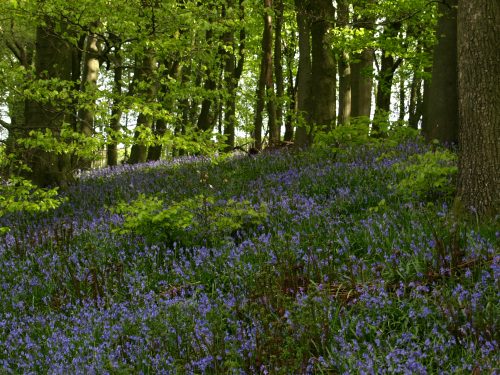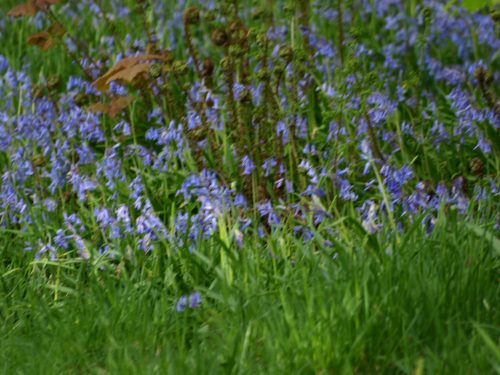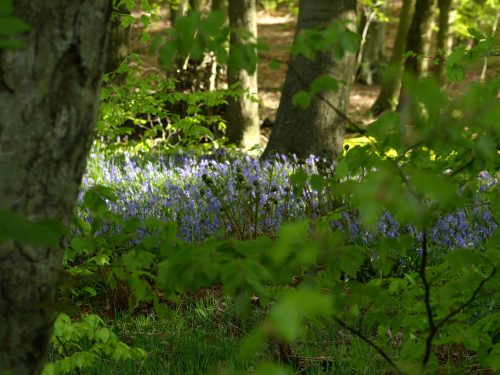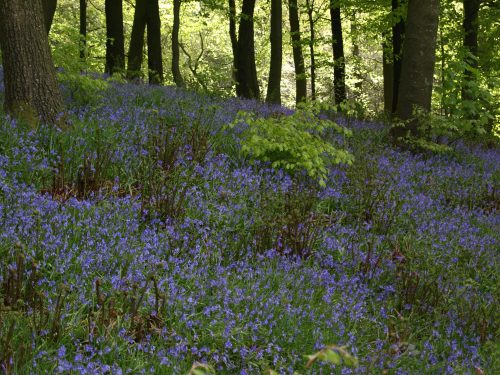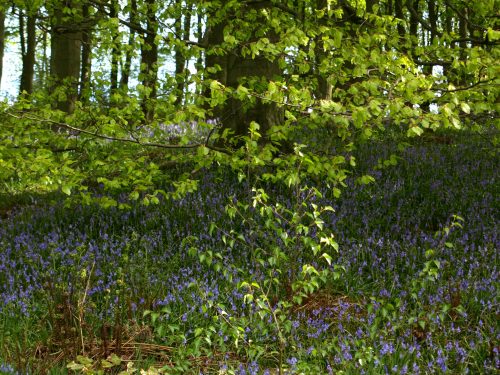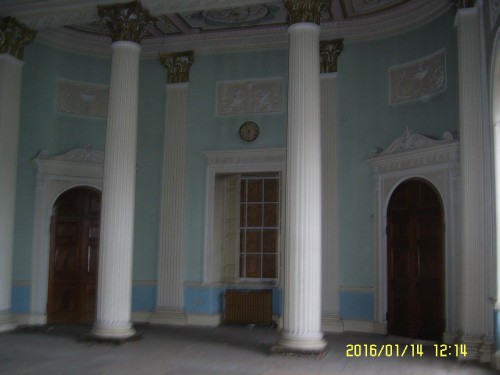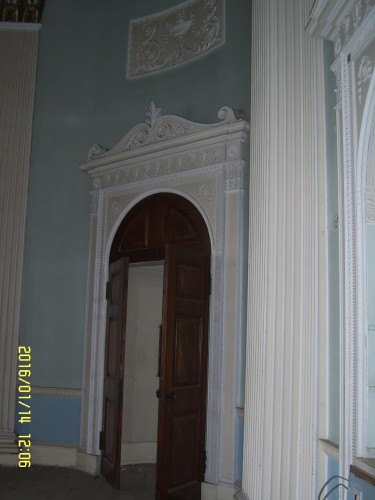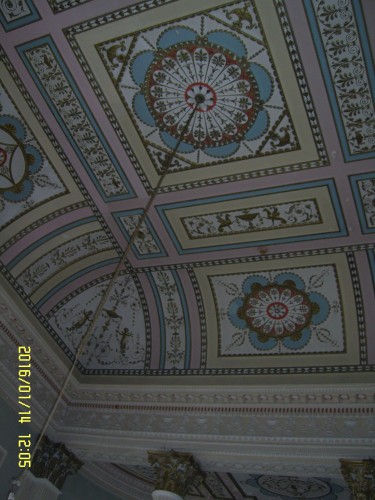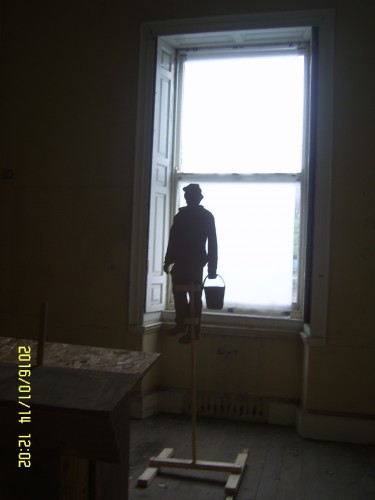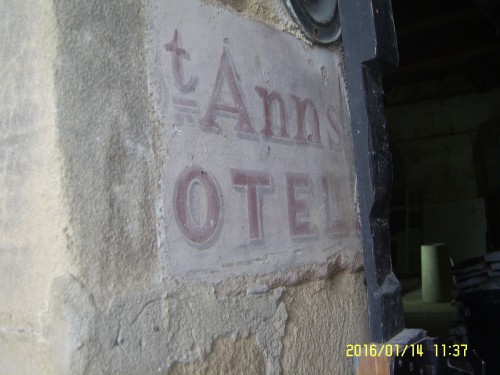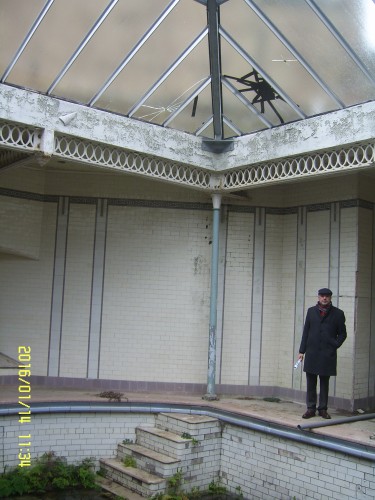News and Events
We love to hear about your experience and see your photographs through the seasons. Don't forget to follow us on Facebook and share our pages. We know we've done a great job when you've had a fantastic day out!
Cooking from the Past
From the Fish Section - Cod Au Gratin
The second in our series of recipes from the past taken from 'The Buxton Recipe Book' published in 1912.

Take a piece of the middle of a cod, boil it (not too much) in salted water and divide into flakes. With ½ pint of the water in which the fish was boiled, make rather a thick white sauce, using 2oz of butter to 1oz of flour with a grate of nutmeg and salt and pepper to taste. Butter and rub with a shallot a dish which will stand the heat of the oven; arrange on it a foundation of mashed potatoes. Make a layer of flakes of cod, mask with the sauce and add a grating of parmesan cheese. Make another layer of fish etc and strew lightly over the whole some w ell-dried bread crumbs. Put the dish in a brisk oven and serve directly the dish is a golden brown.
This reipe was contributed by Mrs Brittain, Melrose, Park Road, Buxton. Make a note in your diary to have a look at the display of snowdrops in the front garden in February.
This contributor must be Vera Brittain’s mother, close to the time her daughter was working at The Dome, formerly the Devonshire Royal Hospital – see Vera’s book, “Testament of Youth”.
Places and Spaces
Litter Picking Lovers Leap
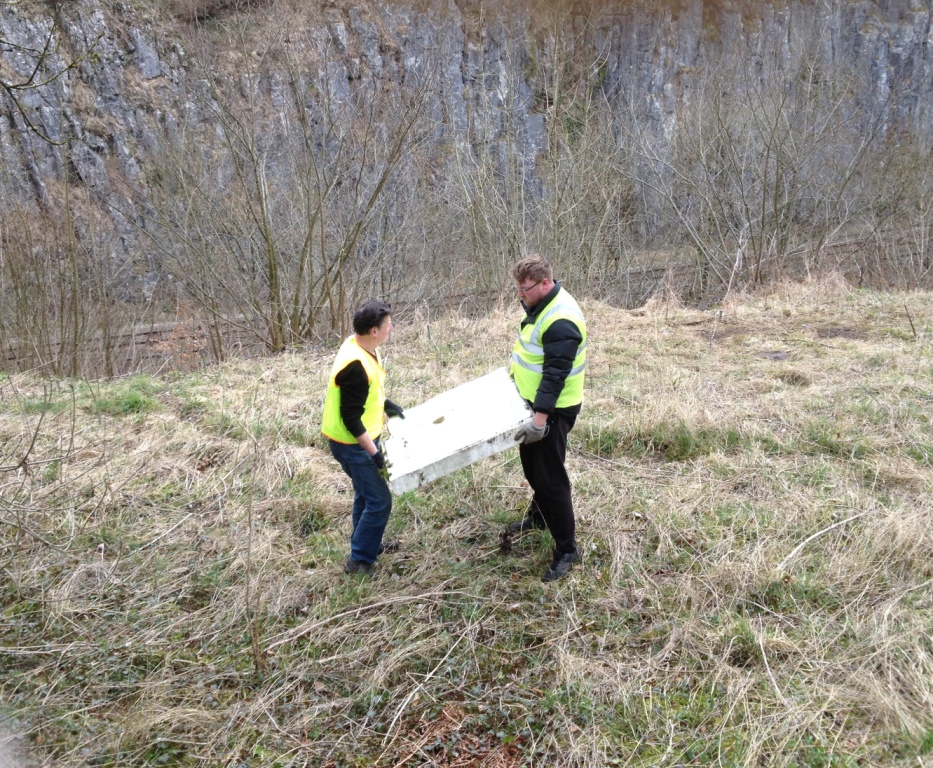
Man handling the shower base
The name Lovers Leap conjures up romantic and perhaps tragic associations. Once a popular spot with Victorian couples, it is less visited now and it is true that the years have rolled by without anyone paying much attention to the condition of this secluded beauty spot located just outside Buxton.
Even so, members of Buxton Civic Association where stunned by the tide of rubbish they encountered when they surveyed the site earlier this year. Both the gorge itself and the slopes above the western cliff-face were strewn not only with bottles and cans but also bits of car bodywork, dumped kitchen appliances and building materials.
On 1 April, a small team of BCA members began the clean-up of the partially terraced slopes above the western cliffs. BCA Business Development Manager, Simon Fussell asked team leader, Roger Floyd, on site, what the team had found there. He replied that, clearly, for a long while, pedestrians on Dukes Drive and people in passing vehicles had been throwing bottles, cans, fast-food containers and other litter over the boundary wall onto the site. But that was far from the whole story.
“Parking here is awkward and access to the site if you are carrying large or heavy items is difficult”, he continued. “Buxton has an easy-to-reach, convenient-to-use, recycling centre where anyone can dispose of reasonable amounts of any kind of waste. And yet, inexplicably, some people seem to have actually chosen to dump items on this beauty spot rather than at the recycling centre. “For example”, he added, pointing to a curious rectangular object near our feet, “this 60 kg concrete shower base”.
Earlier in the day, two of the team had found three abandoned tents on the site. One was full of old clothes. The other two were fully equipped with cooking gear and bedding. Everything was in an advanced state of decay but clearly, at some time in the not to distant past, more than one person had been living there and for an extended period.
Our team were certain that was an ‘extended period’ because amongst the other detritus were 16 two-litre bottles all filled with a yellow fluid. Alas, hopes that it was a collection of rare vintage French wines were soon dashed when one of the bottles was opened. One of our campers had been collecting his own urine. Why? We shall never know. But he certainly didn’t amass his stockpile overnight.
In the end the bottles were left in the tent where they were found. The tents were then bundled up and left on Dukes Drive with the 25 sacks of litter, the shower base and other debris that the team had gathered from the site. To its great credit, the Borough’s Street Care and Cleaning Service sent a truck immediately to pick it all up, even though it was now late on Friday afternoon.
We expect that another three clean-ups will be necessary to clear the whole site.
Anyone for a glass of Chardonnay?
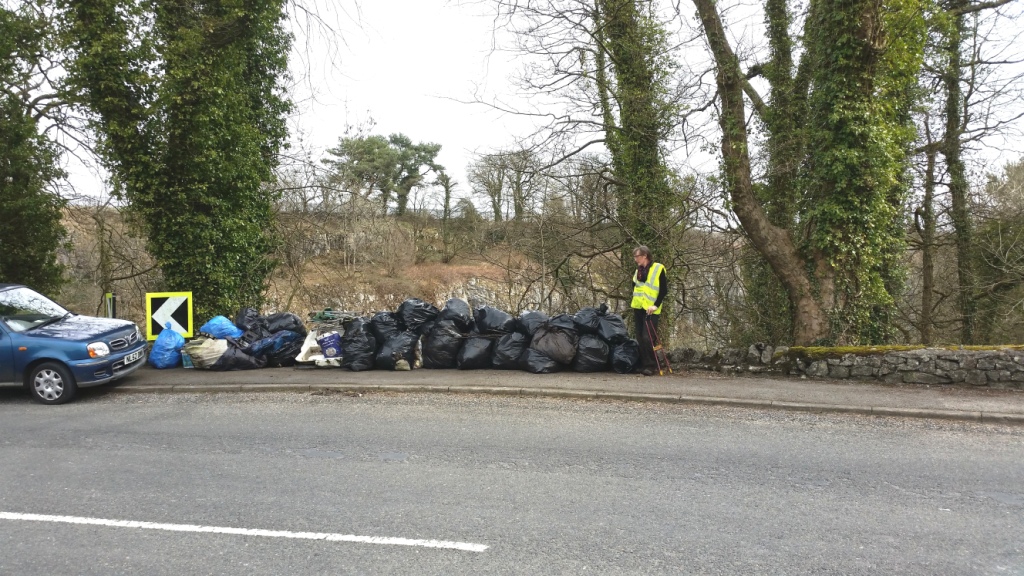
The fruits of a mornings litter picking at Lover's Leap
Buxton on the Move
Cooking from the Past
Recipe One - Soup by Olive Middleton
RECIPES FROM OLD BUXTON
The recent discovery of a pre-First World War booklet contains not only fascinating advertisements from shops and businesses in the town, but also for many dishes of the time sent in by residents.
Comprising savoury and sweet dishes as well as household remedies, it was discovered by the proprietors of the Lee Wood Hotel and made available to BCA. The booklet was printed in 1912 for the benefit of The Home of Rest Furnishing Fund, which was in West Street. Moreover, it contains the name of each contributor and the house name or road of where they lived.
Should you yourself have any memories or information about the contributors mentioned or where they lived – or indeed a favourite recipe of your own – do let us know. It may be that we can make use of them in a future publication.
The headings for each section are: SOUPS, FISH, ENTREES, MEAT, PUDDINGS, SWEETS, SAVOURIES, VARIOUS, INVALID COOKERY and MISCELLANEOUS.
Here for your entertainment is the very last one! It takes us right back to the era of Donkey Stone, Rag and Bone Men, Dolly Blue and home-made starch. . .
“FOR WASHING UP”
Mix a pennyworth of bath-brick, 2 ozs of dry soap powder, 2 tbspns of whitening well together, fill a tin with the mixture and punch some holes in the lid. Use for all greasy things. This quantity will last about a month and costs 3d.
And here is the first recipe.We hope you enjoy making it.
RECIPE ONE
SOUP SECTION
SOUP
Take part of the liquid a fowl has been boiled in and add vegetables, a little onion, a tablespoon of pearl barley, 3 ½ oz of macaroni (well soaked), a little cornflour, pepper and salt. Boil all together, add a pint of new milk, and the remainder of the liquid; a little good stock can be added if necessary.
Submitted by Miss M Burgess, Somersby, College Road, Buxton.
Somersby is one of Parker & Unwin’s houses built in the Arts and Crafts style in 1895 – 96.
Newsletter
Buxton Event
Members February Talk
The Buxton Coalfields
Walking on the moors above Buxton, there is little evidence to the casual observer of the industry that for centuries toiled, struggled and sweated to win coal from the rocks beneath the surface. But if one stops and looks at the landscape, some of the traces left by coal mining can just be glimpsed. It was the story, human, geological, historical, of this forgotten industry that was told by Alan Roberts and Lyn Noble to a packed Buxton Civic Association, for their February members talk.
A depression in the ground once formed the base for a ‘gin’, a winding engine that was turned round and round by a horse and its young human charge, braving the elements up on these unforgiving moors day after day. The boy for 6d a day, and the horse presumably for just enough hay and oats as was needed to keep it in some sort of health to do its job.
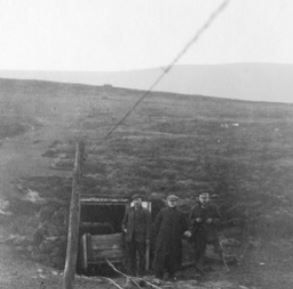
Cisterns Clough incline
Another depression marks one of the many shafts that litter the landscape, now filled in, but that once were part of an extensive and complex mining operation. Beneath the moors canals were dug to enable boats to bring the coal out of the mines, and everywhere water was a problem, constantly needing to be pumped out to make the passages safe for the miners.
Once on the surface, the preferred method to transport the coal to its destination was by pack horse. One can see the evidence, the deeply grooved "Holloways", green now, but in the depths of winter these would be filled with mud, making progress slow and difficult.
Much of the coal, which was of a poor quality, was taken to help fuel the kilns of Grin low. The poor quality led to the large ash and slag tips that now litter the hillside, but hidden by the trees planted in the 1790's.
Alan Roberts, author of ‘The Coal Mines of Buxton’ put the industry into its historic and personal context. The boy who led the horse round and round winding the buckets up and down on the moor top was Anthony Ashmore, as identified in records from the day. (We don't know the name of the horse) for his 6d a day. By comparison, visitors to the Card Room in the Crescent paid 5 shillings entry fee to look around and admire the architectural splendours of the building, funded in part by the rent from the coal licences.
Lyn Noble then explained how a self-guided heritage trail walk had been conceived. It was first tested in the heavy rain and wind of an August afternoon, an experience shared by thirty members and friends of the Civic Association.
The walk has been designed to take the walker on an historical journey of the Buxton Coalfields, working back in time to the earliest recorded mining in the 16th Century up to the 19th Century with its winding wheels, levels and fire houses.
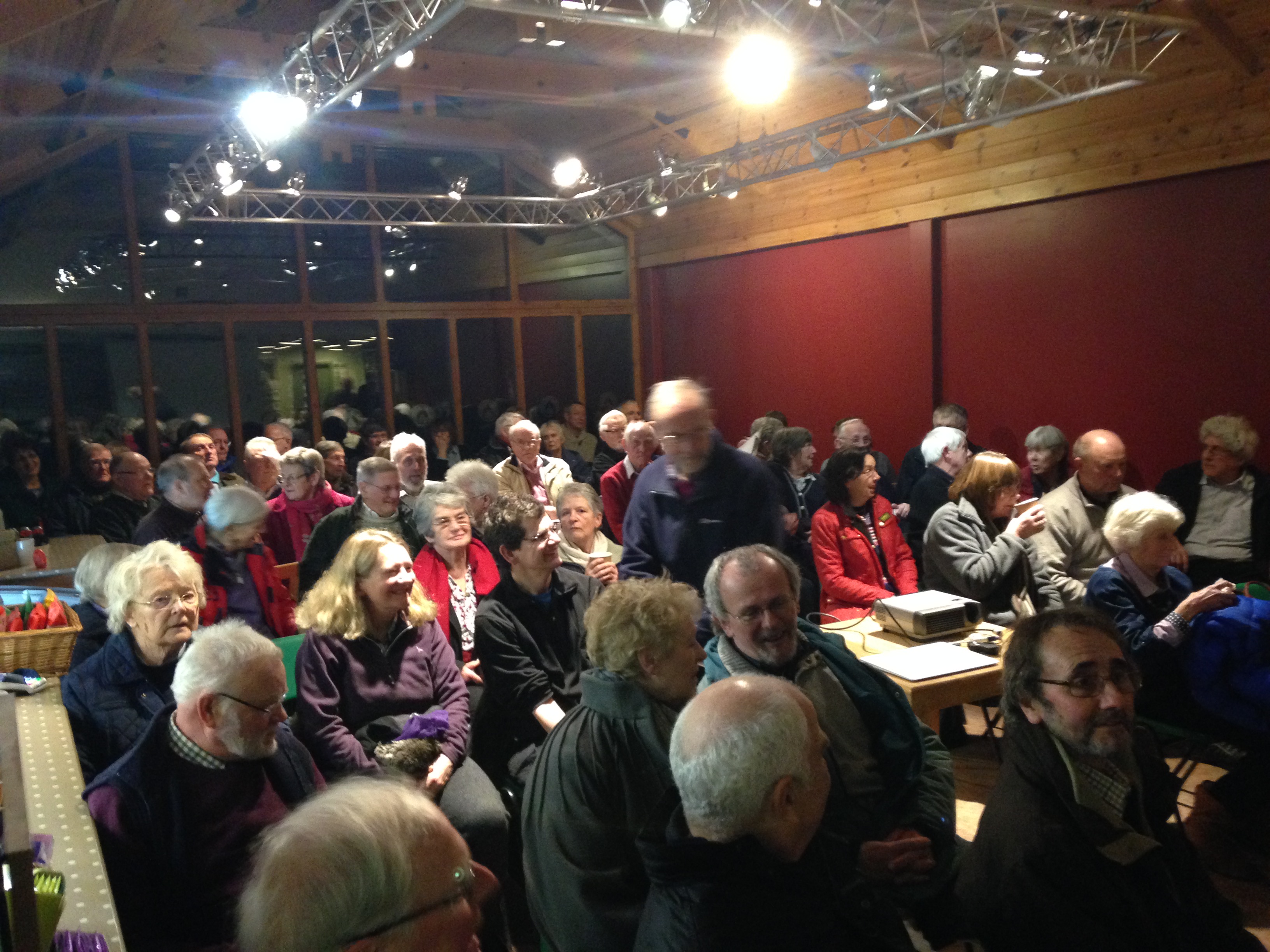
Poole's Cavern Visitor Centre filling up before the talk
The effects of the mining can still be felt today as Lyn explained why after particularly heavy rainfall, the river in the Serpentine gardens turns red. The water flows out of the Old Duke's level and is the result of the Red Iron Oxide that accumulated in the level.
The talk was rounded off with a sing along to an old miner's song “Dark as a Dungeon" with Lyn providing the lead vocals and musical accompaniment.
The heritage trail walk of the Buxton Coalfields will be available shortly as a guide from the Poole's Cavern shop.
The next talk is on 17th March at 7.30pm at Poole’s Cavern Visitor Centre. The Talk is entitled “Butterflies of Grin Woods” to be given by Steve Orridge.
Winter Talk – Bialowieza Forest
The last Primeval Forest In Europe
Imagine walking along a woodland trail deep in the heart of an ancient wood. Birds sing from almost every branch, filling the air with their song. The trees tower forty metres or more above your head and around you, on the ground, the dead and the dying trunks are alive with fungi and insects.
Imagine as the trail turns a corner in this ancient woodland, you briefly glimpse a dark shape, a shadow, as some creature of the forests breaks cover ahead of you. Was it a wolf, a bison or a wild boar? Your heart rate accelerates and for a moment you are back with your ancestors as the flight or fight instinct tries to take over.
Or is it your imagination playing tricks on you, surrounded as you are by the forest, its legends and stories stretching back 10,000 years. The shape disappears and the bird song, temporarily drowned out by the rush of fear you felt, returns and you continue, more cautiously now, on your way.
This is Bialowieza, the forest that straddles the Polish, Belarus border, and is the largest remaining area of European lowland wild wood that once stretched from Siberia to Ireland.
To a packed visitor centre at Poole's Cavern, Buxton Civic Association members and friends listened enthralled as Peter Phillipson, aided by Susan Cross brought the forest to life, with a clever combination of words, pictures and sound recordings, to show the beauty, tranquility, and astounding variety of life in this world heritage site.
Key to the forest's richness of biodiversity is the deadwood and the animals that thrive there. As much as 50% of the trees are dead, either fallen or in some cases still standing. But the "decay is the future", as the forest recycles the nutrients from the dead wood, aided by a wealth of fungi and invertebrates for the next generation of trees.
Wild boar root amongst the leaf litter turning the top two inches over, to provide a habitat for plants and insects, bison create small clearings and the beavers dam the rivers and so reengineer the landscape and create new places for flora and fauna to thrive..
The deer population is kept in check by the Lynx and the Wolf packs so the young saplings are not over grazed. So the cycle continues and has done for thousands of years.
There are challenges to overcome, and tensions between the foresters and ecologists. But the central section of the forest is effectively closed off and nature left unhindered to do what it does best. Access is limited to the fortunate few and then only for a few hours.
Bialowieza is a shining example of how to do conservation. It is a reminder of the landscapes that we have lost but also an example of what can be achieved if the will and understanding is there.
Members Trip
A first glance inside the Crescent
I was very excited to be given the chance to see inside the Crescent for the first time, so immediately returned the form which had come with the
BCA December newsletter. I was happy to get a place on the tour.
There was a full contingent from the BCA, together with a group from the University of Derby, making a rather large group or around 45 for the tour. Nevertheless, our hosts (Richard Tuffrey and Liz McKenzie) coped admirably with the larger than anticipated group and off we went.
Their enthusiasm for the project and confidence in the works was to be admired. The Crescent was fully closed in 1992 and is now on-track to re-open in 2018. Our tour notes explained that the underpinning management structure for the development is “partnership” between the interested parties who include: High Peak Borough Council, Derbyshire County Council, Danubius Hotels Group, Trevor Osborne Property Group, Heritage Lottery Fund, Historic England and The University of Derby.
From the introductory talk, it was made very clear that this partnership recognises the great importance of involving the local community: it is a project for Buxton.
To emphasise this, Liz talked enthusiastically about the links the project will have with schools and community groups, providing tours which give children and adults a profound insight to the history of Buxton as well as that of the Crescent.
The proposals are already widely known, but involve a natural thermal mineral water spa, a 79 bedroom five star spa hotel, 6 boutique scale shops with the Pump Room providing a Buxton Crescent Experience visitor centre.
The area to the front of the Crescent is to be enhanced. Further development of the rear of the Crescent involves an indoor / outdoor spa water pool. We were advised that a huge amount of invisible preparatory work has already taken place underground, necessary to ensure the security of the spa water supply.
The Pump Room work is well under way and the main Crescent contract is due to start in Spring 2016. The Buxton Crescent and Thermal Spa is scheduled to open in 2018; it would be the leading Spa Hotel in the UK.
By this time, there were questions from the group which reflected a level of scepticism. However, we were advised that this is a high status project comprising a £46 million investment, making it one of the largest heritage construction contracts in the East Midlands and contributing to the Buxton’s £83 million heritage regeneration programme. The University of Derby and Danubius have an agreement that the Crescent project will support the UK’s only B.A. (Hons) degree in International Spa Management.
The final part of the answer addressed employment, as the Crescent project will created over 140 full time jobs directly and over 300 indirect full time jobs. While this response could have been discussed for some time, we then began the tour of the Crescent.
It was clear from the start that the interior has stood empty and unheated for some years: faded beauty. However, the roof appeared sound and there was not a smell of damp or rot. It appeared that some activity had been going on, but the day we visited was very quiet. As we were carefully guided through the various areas, Richard and Liz pointed out interesting features and were able to paint a picture of how it would look when complete.
With various pools and sympathetic restoration of the former grand vision, it became quite exciting to think of how it could look. Offerings will include plunge pools, mud and spa treatments which will be familiar to many who have travelled in Europe. We were amused to hear that local peat (under licence) will also be used. The importance of having a town on your doorstep when you want to have a break from the hotel should not be underestimated by local businesses.
However, for me, the highlight was when we arrived at the Function Room. With its ornate ceiling and décor dating back to 1789, this would be the star of the crescent and will remain a function room for both hotel and community. It will be available to be booked by the public for a minimum of 60 days a year set aside for private functions. Some discussion between the developers and The Duke of Devonshire is currently taking place to establish a working protocol for this.
In conclusion it is clear that we are at the start of a new era. The tour confirmed that there are huge plans and sums of money involved, together with a driving determination to make this regeneration project a success. However, my clearest memory is of the faith and confidence demonstrated by Richard and Liz, both of whom are resolute in their faith that the Crescent will live again and be a source of pride for the people of Buxton and the High Peak.
The introduction and tour lasted 90 minutes
Diane White
January 2016
Photographs below courtesy of Andrew Banks and Diane White

